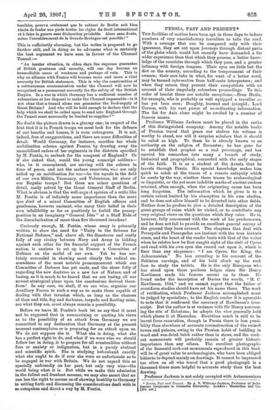PERSIA, PAST AND PRESENT.*
THE facilities of motion have been apt in these days to induce numbers of very unsatisfactory travellers to take the road. With a courage that can be compared only with their ignorance, they set out upon journeys through distant parts of the globe which would but recently have demanded a far wider experience than that which they possess, a better know- ledge of the countries through which they pass, and a greater intimacy with foreign tongues. Their eyes see little but the dirt or the scenery, according to the temperament of their owners ; their ears take in what, for want of a better word, may be termed information from half-caste interpreters ; and when they return they present their compatriots with an account of their singularly colourless proceedings. To this order of tourist there are notable exceptions,—Sven Hedin, for example, who is probably as well equipped a traveller as has yet been seen; Doughty, learned and intrepid ; Lord Curzon, with his vast power of co-ordinating information. The list for Asia alone might be swelled by a number of famous names.
Professor Williams Jackson must be placed in the ranks of this distinguished company. Among the notable books of Persian travel that grace our shelves his volume is worthy to stand, nor will it surprise scholars that it should be rated so high. To them he is already known as an authority on the religion of Zoroaster ; he has gone far to establish that prophet as a real personage, and has carried his researches into many a branch of study, historical and geographical, connected with the early stages of the faith. It is as a student of the Avesta that he travels through Persia. His special knowledge makes him quick to catch at the traces of a remote antiquity which he meets by the way, whether these traces be archaeological or linguistic, or the yet more indelible marks of ancient custom retained, often enough, when the originating cause has been long forgotten. The information which he gives is to a certain extent limited by his absorption in his own studies, and he does not allow himself to be diverted into other fields. Neither does he profess to give a detailed description of the great groups of ruins which he visited, or to contribute any very original views on the questions which they raise. He is, however, fully conversant with the work of his predecessors, and he does not fail to provide an excellent general survey of the ground they have covered. The chapters that deal with Persepolis and Pasargadae are instinct with the true historic sense, and the heart of the reader beats with that of the writer when he relates how he first caught sight of the Age of Cyrus and read with his own eyes the record cut upon it, which is finer than any eloquence : "I am Cyrus, the King, the Achaemenian." No less arresting is his account of the Behistun carvings, and of his bold climb up the rock face to study the tablets. He is the only European who has stood upon those perilous ledges since Sir Henry Rawlinson made his famous ascent on to them. lie found under the inscription of Darius the words, "II. C Rawlinson, 1844," and we cannot regret that the father of cuneiform studies should have set his name there. The work of verification, which Professor Jackson accomplished must be judged by specialists ; to the English reader it is agreeable to note that it confirmed the accuracy of Rawlinson's tran- script. But the author is at variance with Sir Henry concern- ing the site of Ecbatana ; he adopts the view generally held which places it at Hamadan. Doubtless much is still to be learnt from excavation, though in Persia there is less possi- bility than elsewhere of accurate reconstruction of the ruined towns and palaces, owing to the Persian habit of building in wood and sun-dried brick rather than in stone, and the rock- cut monuments will probably remain of greater historic importance than any others. The excellent photographs of the Saasanid rock-cut monuments reproduced in this book will be of great value to archaeologists, who have been obliged hitherto to depend mainly on drawings. It cannot be impressed too often on all who travel that a good photograph is a thousand times more helpful to accurate study than the best drawing.
Professor Jackson is not solely occupied with Achaemenians
Persia, rag and Present. By A. V. Williams Jactson, Protestor of /ado. Iranian Languages 1st Colombia 1Joivoreity, London s M.,ilhan ad Co. Ens. net.] and Sassanids. In his two chapters on Yezd there is a deeply interesting picture of the modern Zoroastrian community. We have already made the acquaintance of the leading Guebres of Yezd in Professor Browne's delightful pages, which inspired his readers with so much sympathy for this handful of survivors of a great creed that they will be glad to follow their subsequent fortunes, and to learn that the measure of toleration extended to them in Professor Browne's time has been maintained and even increased. This is due in great part to the efforts of their co-religionists, the Persia of Bombay. Since Professor Williams Jackson wrote, the Zoroastrians have been granted the right to send a representative to the new Parliament, and the official recognition of the sect must have a certain im- portance, even if the privilege of sitting in a Persian Parlia- ment be not very valuable.
Professor Jackson promises us a second volume on Trans- caspia and Eastern Persia. We look forward to it with pleasure, for his admirable knowledge of the geographers, Arab and European, should enable him to elucidate some of the disputed points in those districts.











































 Previous page
Previous page